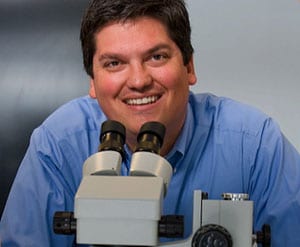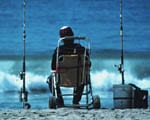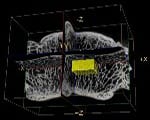Book a live interview

To book a live or taped interview with Marc Christensen in the SMU News Broadcast Studio call SMU News at 214-768-7650 or email news@smu.edu. |
A new $5.6 million center funded by the U.S. Department of Defense and industry is led by SMU’s Lyle School of Engineering to develop revolutionary technology for advanced prosthetic limbs that will help amputees returning from war in Iraq and Afghanistan.
Two-way fiber optic communication between prosthetic limbs and peripheral nerves will be key to operating realistic robotic arms, legs and hands that not only move like the real thing, but also “feel” sensations like pressure and heat.
Journalist David Hambling in New Scientist magazine reported on the technology and the research center in the Oct. 17 article “Robot limbs to plug into the brain with light.”
The center is led by Marc Christensen, chair of the Department of Electrical Engineering in SMU’s Bobby B. Lyle School of Engineering.
Related links

To book a live or taped interview with Marc Christensen in the SMU News Broadcast Studio call SMU News and Communications at 214-768-7650 or email news@smu.edu. |
Related links
|
The Dallas Observer on its Unfair Park blog took note of the SMU-led Neurophotonics Research Center being funded by the Department of Defense and industry with a $5.6 million grant.
In the Sept. 13 entry, Journalist Robert Wilonsky explained details of the project to Observer readers and quoted Marc Christensen, electrical engineering chair in SMU’s Lyle School of Engineering.
“Enhancing human performance with modern digital technologies is one of the great frontiers in engineering. Providing this kind of port to the nervous system will enable not only realistic prosthetic limbs, but also can be applied to treat spinal cord injuries and an array of neurological disorders,” Christensen is quoted.
EXCERPT:
By Robert Wilonsky
SMU and the Department of Defense are already partners on that paper-thin camera straight outta 1984 by way of Minority Report. Now the Hilltop sends word of its latest DOD partnership — a $5.6-mil Neurophotonics Research Center that’ll be run by Marc Christensen, electrical engineering chair in SMU’s Lyle School of Engineering. Its charge: to develop prosthetic limbs using fiber optics that actually feel things like pressure and temperature. Says SMU: “Lightning-fast connections between robotic limbs and the human brain may be within reach for injured soldiers and other amputees.”
DOD, industry fund $5.6 million SMU-led research center; Lyle School technology drives development of advanced prosthetics
Book a live interview

To book an inter- view with Marc Christensen in the SMU Broadcast Studio call 214-768-7650 or email news@smu.edu. |
| Read more SMU technology research |
Lightning-fast connections between robotic limbs and the human brain may be within reach for injured soldiers and other amputees with the establishment of a multimillion-dollar research center led by SMU engineers.
Funded by a Department of Defense initiative dedicated to audacious challenges and intense time schedules, the Neurophotonics Research Center will develop two-way fiber optic communication between prosthetic limbs and peripheral nerves.
This connection will be key to operating realistic robotic arms, legs and hands that not only move like the real thing, but also “feel” sensations like pressure and heat.
Successful completion of the fiber optic link will allow for sending signals seamlessly back and forth between the brain and artificial limbs, allowing amputees revolutionary freedom of movement and agility.
Potential to patch injured spinal cord
 |
 |
 |
Partners in the Neurophotonics Research Center also envision man-to-machine applications that extend far beyond prosthetics, leading to medical breakthroughs like brain implants for the control of tremors, neuro-modulators for chronic pain management and implants for patients with spinal cord injuries.
The researchers believe their new technologies can ultimately provide the solution to the kind of injury that left actor Christopher Reeve paralyzed after a horse riding accident. “This technology has the potential to patch the spinal cord above and below a spinal injury,” said Marc Christensen, center director and electrical engineering chair in SMU’s Lyle School of Engineering. “Someday, we will get there.”
The Defense Advanced Research Projects Agency (DARPA) is funding the $5.6 million center with industry partners as part of its Centers in Integrated Photonics Engineering Research (CIPhER) project, which aims to dramatically improve the lives of the large numbers of military amputees returning from war in Iraq and Afghanistan.
Currently available prosthetic devices commonly rely on cables to connect them to other parts of the body for operation — for example, requiring an amputee to clench a healthy muscle in the chest to manipulate a prosthetic hand. The movement is typically deliberate, cumbersome, and far from lifelike.
A link compatible with living tissue
The goal of the Neurophotonics Research Center is to develop a link compatible with living tissue that will connect powerful computer technologies to the human nervous system through hundreds or even thousands of sensors embedded in a single fiber.
Unlike experimental electronic nerve interfaces made of metal, fiber optic technology would not be rejected or destroyed by the body’s immune system.
“Enhancing human performance with modern digital technologies is one of the great frontiers in engineering,” said Christensen. “Providing this kind of port to the nervous system will enable not only realistic prosthetic limbs, but also can be applied to treat spinal cord injuries and an array of neurological disorders.”
The center brings together researchers from SMU, Vanderbilt University, Case Western Reserve University, the University of Texas at Dallas and the University of North Texas.
The Neurophotonics Research Center’s industrial partners include Lockheed Martin (Aculight), Plexon, Texas Instruments, National Instruments and MRRA.
Integrated system at cellular level
Together, this group of university and industry researchers will develop and demonstrate new increasingly sophisticated two-way communication connections to the nervous system.
Related links
- Vanderbilt University: New initiative to develop a system that controls prosthetic limbs naturally
- Optics Express: Tuning of whispering gallery modes of spherical
resonators using an external electric field - Marc Christensen
- SMU Profile: Marc Christensen
- Volkan Otugen
- Micro-Sensor Laboratory
- SMU Department of Electrical Engineering
- SMU Department of Mechanical Engineering
- Bobby B. Lyle School of Engineering
More SMU Research news

Snail mail beats phones to help feds sustain ample fish stocks in U.S. coastal waters |

Africa’s cell phone boom can’t trump dire need for schools, roads, power, water |
Every movement or sensation a human being is capable of has a nerve signal at its root. “The reason we feel heat is because a nerve is stimulated, telling the brain there’s heat there,” Christensen said.
The center formed around a challenge from the industrial partners to build a fiber optic sensor scaled for individual nerve signals: “Team members have been developing the individual pieces of the solution over the past few years, but with this new federal funding we are able to push the technology forward into an integrated system that works at the cellular level,” Christensen said.
The research builds on partner universities’ recent advances in light stimulation of individual nerve cells and new, extraordinarily sensitive optical sensors being developed at SMU. Volkan Otugen, SMU site director for the center and Lyle School mechanical engineering chair, has pioneered research on tiny spherical devices that sense the smallest of signals utilizing a concept known as “whispering gallery modes.” A whispering gallery is an enclosed circular or elliptical area, like that found beneath an architectural dome, in which whispers can be heard clearly on the other side of the space.
Ultimate combination for two-way interface
The ultimate combination of advanced optical nerve stimulation and nerve-sensing technologies will create a complete, two-way interface that does not currently exist. “It will revolutionize the field of brain interfaces,” Christensen said.
“Science fiction writers have long imagined the day when the understanding and intuition of the human brain could be enhanced by the lightning speed of computing technologies,” said Geoffrey Orsak, dean of the SMU Lyle School of Engineering. “With this remarkable research initiative, we are truly beginning a journey into the future that will provide immeasurable benefits to humanity.”
A private university located in the heart of Dallas, SMU is building on the vision of its founders, who in 1911 imagined a distinguished center for learning emerging from the spirit of the city. Today, nearly 11,000 students benefit from the national opportunities and international reach afforded by the quality of SMU’s seven degree-granting schools. — Kimberly Cobb
SMU has an uplink facility located on campus for live TV, radio, or online interviews. To speak with Marc Christensen or to book a live or taped interview in the studio, call SMU News & Communications at 214-768-7650 or email news@smu.edu.
Book a live interview

To book a live or taped interview with Daniel L. Millimet in the SMU News Broadcast Studio call News and Communications at 214-768-7650 or email news@smu.edu. |
The link between the federal school lunch program and childhood obesity uncovered by the research of SMU economist Daniel L. Millimet has been reported in The San Angelo Standard-Times in “Study shows obesity has complex origins.”
Writing for the Scrips Howard News Service, reporter Trish Choate quotes Millimet on the research and the link in an article that published Sept. 3 in the Standard-Times.
The research, funded by the U.S. Department of Agriculture, found that children who eat school lunches that are part of the federal government’s National School Lunch Program are more likely to become overweight.
The same research study found, however, that children who eat both the breakfast and lunch sponsored by the federal government are less heavy than children who don’t participate in either, and than children who eat only the lunch, said Millimet.
Millimet authored the study with economists Rusty Tchernis, Georgia State University, and Muna S. Hussain, Kuwait University.
Related links
- School Nutrition Programs and the Incidence of Childhood Obesity
- Daniel L. Millimet
- USDA and First Lady Michelle Obama: Let’s Move Initiative
- Report: White House Task Force on Childhood Obesity
- SMU Department of Economics
More SMU Research news
The new study was published in the Summer issue of The Journal of Human Resources. It is titled “School Nutrition Programs and the Incidence of Childhood Obesity.”
Millimet is a professor and director of undergraduate studies in the SMU Department of Economics.
EXCERPT:
SAN ANGELO, Texas — WASHINGTON — A new study indicates a link between childhood obesity and school lunches, as well as a connection between healthier children and school breakfasts.
Elementary schoolchildren eating lunches at schools participating in the federally funded National School Lunch Program are more likely to become overweight, said a professor at Southern Methodist University in Dallas who co-authored the study sponsored by U.S. Department of Agriculture.
But children eating both federally funded school breakfasts and school lunches tend to be leaner than those eating only the lunch, SMU economist Daniel L. Millimet said.
“I think breakfast is a more important meal in terms of maintaining a healthy weight than lunch,” Millimet said.
Also, other studies have indicated school breakfasts comply better with government nutrition regulations than school lunches, he said.
Also covering the research is AlterNet’s Emily Badger, with the story “Do School Lunches Plump Up Poor Kids?” The story, which was posted Sept. 3, quotes Millimet on whether there’s a “causal” effect and asks “Does the National School Lunch Program make children obese, or are obese children simply more likely to sign up for the program in the first place?”
EXCERPT:
Students who participate in the National School Lunch Program are more likely to come from lower-income families or families with two working parents who don’t have time to pack a brown-bag lunch the night before. Those same students, as a quick glance around many school cafeterias this fall will show, are also more likely to be overweight.
The challenge for researchers and policymakers has been to sort out the relationship between the two.
“When you just look at those groups
[who participate in school lunch], those are groups also more likely to not be the healthiest kids,” said Daniel Millimet, an economist at Southern Methodist University. “Then there’s a question of whether or not there’s actually something causal going on, or does the perception just reflect people who are self-selecting into the program?”
In other words: Does the National School Lunch Program make children obese, or are obese children simply more likely to sign up for the program in the first place?
Read the full story
SMU has an uplink facility located on campus for live TV, radio, or online interviews. To speak with an SMU expert or book an SMU guest in the studio, call SMU News & Communications at 214-768-7650 or email news@smu.edu.
Federal school lunches linked to childhood obesity, says SMU research
- Post author By Margaret Allen
- Post date August 19, 2010
 With children going back to school, parents are concerned that their youngsters are staying fit and eating right, especially those who dine in a school cafeteria.
With children going back to school, parents are concerned that their youngsters are staying fit and eating right, especially those who dine in a school cafeteria.
New research funded by the U.S. Department of Agriculture finds that children who eat school lunches that are part of the federal government’s National School Lunch Program are more likely to become overweight.
The same research study found, however, that children who eat both the breakfast and lunch sponsored by the federal government are less heavy than children who don’t participate in either, and than children who eat only the lunch, says economist Daniel L. Millimet at Southern Methodist University in Dallas.
Millimet authored the study with economists Rusty Tchernis, Georgia State University, and Muna S. Hussain, Kuwait University.
“The fact that federally funded school lunches contribute to the childhood obesity epidemic is disconcerting, although not altogether surprising,” said Millimet, whose research looks at the economics of children, specifically topics related to schooling and health.
Book a live interview

To book a live or taped interview with Daniel L. Millimet in the SMU News Broadcast Studio call News and Communications at 214-768-7650 or email news@smu.edu. |
The new study was published in the Summer issue of The Journal of Human Resources. It is titled “School Nutrition Programs and the Incidence of Childhood Obesity.”
The U.S. Department of Agriculture oversees the federal lunch and breakfast programs. Through USDA the federal government reimburses schools for a portion of school lunch costs and also donates surplus agricultural food items. While USDA does require that the meals meet certain nutritional standards, schools choose the specific foods.
A la carte items outside the guidelines
Schools also can serve individual food items a la carte, which fall outside the scope of the federal guidelines and allow students to choose additional foods.
For their study, the researchers analyzed data on more than 13,500 elementary school students. Students were interviewed in kindergarten, first and third grades, and then again in later grades.
Related links
- School Nutrition Programs and the Incidence of Childhood Obesity
- Daniel L. Millimet
- USDA and First Lady Michelle Obama: Let’s Move Initiative
- Report: White House Task Force on Childhood Obesity
- SMU Department of Economics
More SMU Research news
“First, it is very difficult to plan healthy but inviting school lunches at a low price,” Millimet said. “Second, given the tight budgets faced by many school districts, funding from the sales of a la carte lunch items receives high priority. That said, it’s comforting to know that the U.S. Department of Agriculture, which oversees the federal school nutrition programs, takes the issue very seriously. The USDA sponsors not only my research, but that of others as well, to investigate the issues and possible solutions.”
The USDA is partnering with First Lady Michelle Obama to fight what experts say is a childhood obesity epidemic among America’s school children. The First Lady on May 18 released the results and recommendations of The White House Task Force on Childhood Obesity report, which said that more than 30 percent of American children ages 2 to 19 are overweight or obese. The report recommends serving healthier foods in schools.
Lunches may not be in compliance
Judging from the results of the study, Millimet said, the food being served in school lunches may not maintain a healthy weight in children. The food in school breakfasts appears to be healthier, however.
“Technically what is going on is that the federal government establishes nutrition guidelines for lunches and breakfasts if schools wish to receive federal funding,” Millimet said. “But there’s evidence that school lunches are less in compliance with these guidelines than breakfasts. The other possible issue is that these days schools try to make money from a la carte items at lunch. And it’s possible that even if the school lunch is healthy, kids buying lunch are more likely to tack on extra items that are not healthy.”
Nutritionists strongly advocate eating breakfast for a healthy lifestyle, Millimet said, noting that — up to a point — any breakfast is better than no breakfast.
The National Student Lunch Program supplies meals to about 30 million children in 100,000 public and nonprofit private schools, according to the USDA.
The School Breakfast Program gives cash assistance to more than 80,000 schools for about 10 million children.
Obesity among students takes jump
The study cites data from the National Health and Nutrition Examination Survey taken between 1971 and 1974 and again from 2003 to 2004 that found the prevalence of overweight preschool children ages 2-5 jumped from 5 percent to 13.9 percent. Among school-aged children, it jumped from 4 percent to 18.8 percent for children 6-11; and 6.1 percent to 17.4 percent for those 12-19.
Millimet is a professor and director of undergraduate studies in the SMU Department of Economics. Tchernis is an associate professor in Georgia State University’s Andrew Young School of Policy Studies, and Hussain is an assistant professor in Kuwait University’s Department of Economics. — Margaret Allen
SMU has an uplink facility located on campus for live TV, radio, or online interviews. To speak with an SMU expert or book an SMU guest in the studio, call SMU News & Communications at 214-768-7650 or email news@smu.edu.







